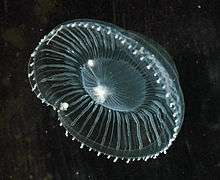Aequoreidae
| Aequoreidae | |
|---|---|
 | |
| Aequorea victoria (the "crystal jelly") with two amphipods | |
| Scientific classification | |
| Kingdom: | Animalia |
| Phylum: | Cnidaria |
| Class: | Hydrozoa |
| Order: | Leptothecata |
| Family: | Aequoreidae Eschscholtz, 1829 |
| Genera[1] | |
| |
Aequoreidae is a family of hydrozoans. There are approximately 30 known species found in temperate and tropical marine coastal environments.[2] Aequoreids include Aequorea victoria, the organism from which the green fluorescent protein gene was isolated.[3]
Polyps
Only the polyp stages of Aequorea species have been observed.[4] The colonies are covered with chitinous periderm and can be either prostrate or erect with weak or sympodial branching.[4] Young hydranths possess hydrothecae with a closing structure called operculum,[4] which consists of several relatively long triangular folds that meet together in the centre when a disturbed polyp contracts.[4] Because the operculum is quite fragile, hydrothecae of old polyps usually have only a small chininous collar remaining.[4] Comparatively large cylindrical gonothecae are attached to the colony with a thin peduncle.[4] Commonly only one medusa develops in each gonotheca.[4]
Medusae
Mature aequoreid medusae are diverse in shape, from lens-like to conical, and in size.[2] The smallest, Aequerea parva is only 0.6 cm in diameter, while the largest, Rhacostoma atlanticum, can reach 40 cm in diameter.[2][4] The medusae of most species are between 5 and 15 cm in diameter.[2]
Genera
Aequoreidae includes the following genera:[1]
- Aequorea Péron et Lesueur, 1810 – ca. 20 valid species
- Aldersladia Gershwin, 2006 – 1 valid species
- Gangliostoma Xu, 1983 – 2 valid species
- Rhacostoma L. Agassiz, 1850 – 1 valid species
- Zygocanna Haeckel, 1879 – 5 valid species
See also
References
| Wikimedia Commons has media related to Aequoreidae. |
| Wikispecies has information related to Aequoreidae |
- 1 2 Peter Schuchert (2011). Schuchert P, ed. "Aequoreidae". World Hydrozoa database. World Register of Marine Species. Retrieved January 20, 2012.
- 1 2 3 4 Kramp, P. L. (1961). Synopsis of the medusae of the world. Journal of the Marine Biological Association of the United Kingdom 40: 1–469. P. 203–212. The full text Archived 2011-09-30 at the Wayback Machine.
- ↑ Tsien, R. (1998). The green fluorescent protein. Annual Review of Biochemistry 67: 509–44. The full text. doi:10.1146/annurev.biochem.67.1.509.
- 1 2 3 4 5 6 7 8 Bouillon, J., Gravili, C., Pagès, F., Gili, J. M., Boero, F. (2006). An introduction to Hydrozoa. Mémoires du Muséum national d’Histoire naturelle 194: 1–591, p. 276–278.